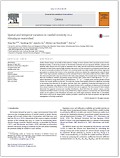| Journal Article |
 |
|
| Article Title | Spatial and temporal variation in rainfall erosivity in a Himalayan watershed | | Author | Xing Ma, Yandong He, Xu Jianchu, Meine van Noordwijk and Xixi Lu | | Year | 2014 | | Journal Title | Catena | | Institution | Elsevier B.V. | | Volume | 121 | | Pages | 248-259 | | Call Number | JA0577-14 | | Keywords | R-factor of RUSLE, Daily rainfall erosivity model, R-factor maps, R-factor variation, Kejie watershed |
|
| Abstract: |
| Global climate change can modify rainfall patterns, leading to more extremes with associated erosion events.
Rainfall erosivity, or the R-factor based on the Revised Universal Soil Loss Equation (RUSLE), indicates the
potential water erosion risk and it plays an important role inwater and soil conservation assessments. However,
calculation of the R-factor requires high resolution data series, and thus we present an alternative model that can
be used to accurately calculate the R-factor. Our erosivity model uses daily rainfall with advised regression
parameters to estimate the R-factor in the watershed, which was selected by comparing the actual R-factor
with 10 min high resolution rainfall data and the estimated R-factor with daily rainfall data from 1998 to 2002.
The mean annual R-factor map was derived in the study using cokriging. The annual R-factor in the Kejie watershed
was classified as medium and medium-strong erosivity, with a mean value of 3264 MJ.mm.ha?1.h?1.yr?1
which represented a range from 2505 to 5538 MJ.mm.ha?1.h?1.yr?1. A simple power relation between annual
R-factor and annual rainfall was derived. The long-term change trend analysis showed no significant increasing
or decreasing trend observed for the region; however, there was a significant increasing trend observed in two
stations in September, one station in March. The annual R-factor with a coefficient of variation of 0.30 indicated
inter-annual variation of the R-factor in the watershed was not so apparent. The intra-annual R-factor analysis
illustrated the apparent seasonal and monthly distribution, about 65% from the summer season, and the
maximum monthly R-factor occurring in July, followed by August and June. Consequently, the adjusted daily
model can be applied in this Himalayan mountain area when high-resolution rainfall data is unavailable.
The R-factor map and the simple power relation provided a useful tool for land-use planner and agriculture
management in the Kejie watershed. |
|
|
Download file(s): Click icon to download/open file.
|
| |
File Size |
Description |

|
1,870 KB |
Softcopy |
|
|
|
| Viewed in 1069 times. Downloaded in 642 times. |